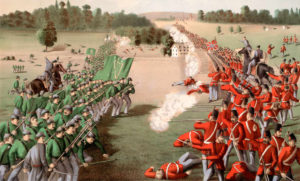The Irish-American Army That Attacked Canada from Buffalo

Thirteen months after Robert E. Lee laid down his sword at Appomattox Court House, former Confederate rebels slipped on their gray wool jackets. Union veterans longing to emancipate an oppressed people donned their blue kepis. Battle-hardened warriors from both the North and the South returned to the front lines, but not to reignite the Civil War. Instead, the former foes became improbable brothers in arms united against a common enemy—Great Britain.
Entwined by Irish bloodlines, the private army that congregated on the south side of Buffalo, New York, in the early morning hours of June 1, 1866, shared not just a craving for gunpowder but a yearning to liberate their homeland from the shackles of the British Empire. For seven hundred years, British rulers attempted to extinguish Ireland’s religion, culture, and language, and when the potato crop failed in the 1840s and 1850s, causing one million people to die, some Irish believed that the British were trying to exterminate them as well.
Many of the two million refugees fleeing the Great Hunger washed ashore in the United States, where the newcomers continued to face the scorn of nativist Know-Nothings who believed the Irish had no intention of assimilating into American culture but plotted to take handout after handout while imposing papal law on their adopted home. Even from a distance of nearly fifteen years and three thousand miles, the trauma remained raw for many of the insurgents who enlisted in the self-proclaimed Irish Republican Army. Radicalized by their collective ordeal, these Irish American Civil War veterans viewed their service in the bloody crucibles of Bull Run, Antietam, and Gettysburg as training for the real fight they wanted to wage—one to free Ireland.
Wearing green ribbons tied to their hats and fastened to their buttonholes, eight hundred Irish paramilitaries who had traveled from as far away as New Orleans emerged from the boardinghouses and saloons of Buffalo’s Irish enclave, the First Ward, on a clear spring night. Carrying green flags sewn by their wives, girlfriends, and mothers and hauling nine wagons laden with secretly stockpiled rifles and ammunition, the Irish Republican Army set off on one of the most fantastical missions in military history—to kidnap Canada.
After leading the Irish Republican Army on their six-mile march through Buffalo, John O’Neill halted his troops at a dock near the Pratt & Co. blast furnace, where the distance across the Niagara River was among its narrowest.
As the Irish colonel surveyed his ragtag force clad in blue, gray, and green, he saw grizzle-bearded men and fair-skinned boys, Catholics and Protestants, Yankees and Rebs. As O’Neill squinted into the darkness, he could faintly make out the enemy territory one thousand yards across the river. Awaiting the troops were two steam tugs and four canal boats, which had been procured by an Irishman posing as a foundry owner seeking to transport his employees to a company picnic on Grand Island.
With Canadian defense forces stationed miles away, the Irishmen easily slipped across the international boundary. The soldiers shook the American dust off their boots and planted their feet firmly on the soil of the British Empire.
The Irish Republican Army’s invasion of Canada had begun.
To read more about the incredible true story of the Civil War veterans who fought for Ireland’s freedom, order WHEN THE IRISH INVADED CANADA from your local bookstore (https://bit.ly/30I90OI), Amazon (https://amzn.to/30FhhTS), or Barnes & Noble (https://bit.ly/2HxPjSc).